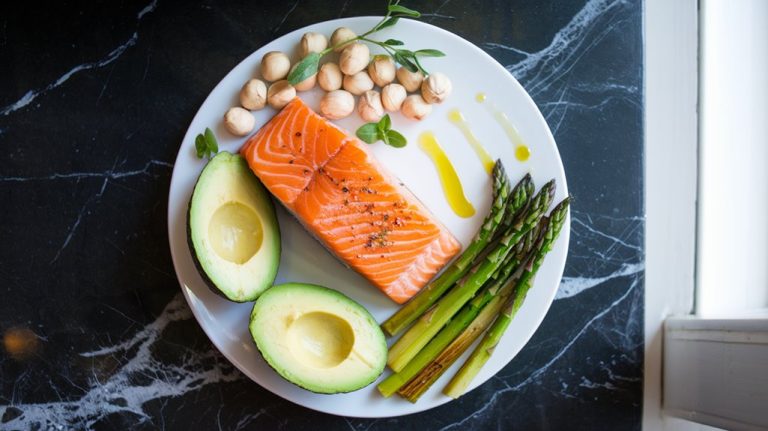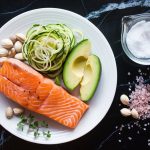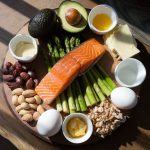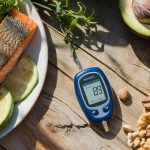Ketocycle 2.0 transforms your metabolism through strategic weekly phases designed to optimize fat burning and energy production. You'll start by breaking carb dependency in week 1, master macro balancing in week 2, and enhance nutrient timing in weeks 3-4. The plan combines precise meal timing, targeted exercise protocols, and recovery periods to push your body into peak ketosis. Following this science-backed progression will reveal the full potential of metabolic adaptation.
Keto Highlights
- Week 1 focuses on breaking carb dependency through strict macro ratios of 70-75% fats while limiting net carbs to 20-30g daily.
- Week 2 transitions to a modified 50/30/20 split of fats, proteins, and carbs, with protein calculated at 1.6g per kg bodyweight.
- Weeks 3-4 incorporate strategic carb refeeds for 1-2 days weekly, making up 60-70% of total calories during those days.
- Fasted morning cardio and timed high-intensity workouts optimize fat oxidation and glycogen depletion throughout the program.
- Strategic meal timing within an 8-hour window and precise workout nutrition enhance metabolic adaptation and performance gains.
Understanding the Science Behind Ketocycle 2.0
The biochemical process of ketosis forms the foundation of the Ketocycle 2.0 plan. When you restrict carbohydrates, your liver begins converting fatty acids into ketone bodies, which become your body's primary fuel source. This metabolic shift occurs within 3-4 days as your body adapts to using fat for energy.
You'll experience significant physiological changes during this conversion. Your insulin levels will drop, promoting fat breakdown, while your mitochondrial function and energy production improve. Your genes involved in fat metabolism become upregulated, enhancing your body's ability to utilize ketones efficiently. While you might initially encounter "keto flu" symptoms, your metabolism will adapt to this new state, potentially leading to improved cognitive function and reduced inflammation markers. It's essential to monitor your electrolyte balance and guarantee proper nutrient intake throughout the process.
Week 1: Breaking Free From Carb Dependency
Breaking free from carbohydrate dependency marks a critical shift during your first week on Ketocycle 2.0, as your body undergoes significant metabolic adaptations. You'll experience glycogen depletion within 48 hours, followed by increased ketone production by day 3-4. Expect to lose 2-4 pounds of water weight as insulin levels drop.
To manage common withdrawal symptoms like fatigue, headaches, and irritability, you'll need to maintain strict macro ratios: 70-75% healthy fats and 20-30g protein every 3-4 hours. Keep your net carbs between 20-30g daily while consuming whole foods like meats, fish, eggs, and low-carb vegetables. Supplement with electrolytes and drink 2-3 liters of water to combat dehydration. Track your intake meticulously and prepare keto-friendly snacks to maintain compliance during sudden hunger episodes.
Week 2: Mastering the Macro Balance
After establishing ketosis in week one, mastering precise macronutrient ratios becomes your central focus during week two of Ketocycle 2.0. You'll shift to a modified 50/30/20 split of fats, proteins, and carbs, respectively, marking a significant change from traditional keto ratios.
Calculate your protein needs at 1.6g per kg of body weight, spreading intake evenly throughout the day. You'll increase carbohydrates to 20% of total calories while reducing fats to 50%, emphasizing plant-based sources like avocados and olive oil. This adjustment supports sustainable weight management while maintaining ketosis.
Track your macros using a keto calculator to guarantee precision. Focus on incorporating fatty fish, nuts, and seeds while limiting red meat and dairy. Include low-carb vegetables to meet your increased carbohydrate allowance without compromising ketosis.
Weeks 3-4: Supercharging Your Nutrient Game
You'll boost your Ketocycle 2.0 results by incorporating plant-based proteins like hemp seeds and pumpkin seeds at strategic intervals throughout your day. When timing your complex carbohydrates, focus on the 2-hour window following resistance training to maximize glycogen replenishment and recovery. Your body's natural fat-burning mechanisms will strengthen through the strategic inclusion of thermogenic foods such as green tea, cayenne pepper, and ginger alongside your primary macronutrients.
Plant Power Protein Tips
Maximizing protein intake on a plant-based diet requires strategic nutrient enhancement during weeks 3-4 of your ketocycle journey. You'll need to focus on combining high-protein plant sources like tempeh, seitan, and lentils to achieve your daily targets of 20-30g protein per meal.
- Pair legumes with quinoa to create complete protein profiles, enhancing amino acid absorption
- Utilize nutritional yeast to boost B-vitamins while adding 9g protein per 2 tablespoons
- Implement sprouting techniques for grains and legumes to maximize nutrient bioavailability
Your supplementation strategy should include B12 (2.4 mcg daily), zinc (8-11 mg), and algae-based omega-3s. For peak athletic performance, add creatine monohydrate (3-5g daily) to your regimen. Pre-planning your meals guarantees consistent protein intake while rotating diverse plant sources throughout your weekly cycle.
Mastering Complex Carb Timing
Strategic carb timing during weeks 3-4 of your ketocycle requires precise coordination to maintain metabolic flexibility while optimizing performance. You'll want to schedule your complex carb refeeds for 1-2 days weekly, ensuring they comprise 60-70% of your total calories on these days.
Structure your refeed windows within a 24-48 hour period, consuming your final carb-rich meal before 6 PM on the last day. Focus on nutrient-dense sources like whole grains, legumes, and starchy vegetables while maintaining proper macronutrient ratios: 15-20% protein and 5-10% fats during the carb-up phase.
To efficiently return to ketosis, perform fasted HIIT training post-refeed, followed by strict ketogenic eating (0-2% carbs) on day one. By day two, incorporate medium-intensity steady-state exercise while gradually returning to your standard ketogenic protocol.
Enhance Fat-Burning Naturally
During weeks 3-4 of the ketocycle, natural fat-burning enhancement requires a systematic approach to micronutrient improvement and metabolic support. You'll need to strategically incorporate nutrient-dense foods while maintaining ketosis through precise macronutrient ratios.
- Boost ketone production by increasing healthy fats to 70-75% of total calories, focusing on MCTs and omega-3 rich sources
- Support metabolic flexibility through resistance training and strategic carb timing around workouts
- Address potential deficiencies with targeted supplementation of D3, K2, and B-vitamins
Your body's fat-burning potential peaks when you combine proper nutrient timing with metabolic-enhancing activities. Monitor ketone levels regularly using blood or breath tests to verify you're maintaining ideal ketosis while incorporating HIIT sessions to maximize metabolic adaptations. Supplement with electrolytes to prevent imbalances during increased activity levels.
Transforming Your Body Through Strategic Meal Timing
When you understand the science of meal timing, you can transform your body composition more effectively than through diet alone. By aligning your meals with your circadian rhythm and implementing strategic feeding windows, you'll enhance your metabolic health and improve nutrient utilization.
To maximize fat loss while preserving muscle mass, restrict your eating window to 8 hours and concentrate your carbohydrate intake around your workouts. You'll need to consume 1-4g/kg of carbs 1-4 hours pre-exercise, followed by a protein-rich meal containing 15-20g of protein for peak recovery. Throughout the day, space your meals 3-5 hours apart and front-load your calories in the morning. This approach will help regulate insulin levels, reduce inflammation, and promote better nutrient absorption while supporting your body transformation goals.
Maximizing Results With Exercise and Recovery

Your workout timing directly impacts both performance and recovery in your ketogenic fitness journey, with research showing ideal results when you align high-intensity training sessions with targeted carbohydrate intake. You'll maximize muscle preservation and energy efficiency by scheduling HIIT or resistance training during your body's peak insulin sensitivity window, typically 4-6 hours after your first meal. Strategic recovery periods between sessions allow for proper muscle repair and glycogen replenishment, essential for maintaining performance while adhering to ketogenic macros.
Strategic Workout Timing
Strategic workout timing plays a pivotal role in maximizing the benefits of a ketogenic lifestyle while enhancing exercise performance. To maintain ketosis and improve fat adaptation, schedule your training sessions according to your body's metabolic state and energy availability.
- Perform fasted cardio in the morning to accelerate fat oxidation and deepen ketosis
- Schedule high-intensity workouts during carb-up periods when glycogen stores are replenished
- Time HIIT sessions at the end of low-carb days to boost glycogen depletion
Structure your workout intensity around your ketocycle phases, limiting high-intensity sessions to 30-45 minutes while maintaining 45-60 minutes for steady-state cardio. Monitor blood ketones and performance metrics regularly to fine-tune your training schedule, and implement deload weeks every 4-6 weeks to prevent overtraining and sustain peak ketosis levels.
Recovery Between Training Sessions
Proper recovery between training sessions forms the cornerstone of successful ketogenic exercise adaptation. Your post-workout nutrition window is critical – consume protein within 30 minutes to initiate muscle repair, while maintaining your keto-friendly macros. Prioritize sleep by getting 7-9 hours nightly, as this optimizes hormonal balance and recovery processes.
Implement active recovery techniques between intense workouts. You'll benefit from foam rolling, compression garments, and strategic stretching to enhance blood flow and reduce muscle tension. Don't skip rest days – they're essential for preventing overtraining and allowing proper adaptation. On these days, focus on light movement and mobility work. Monitor your body's signals closely and adjust your training intensity when you notice persistent fatigue or decreased performance.
Common Challenges and How to Overcome Them
While shifting to a ketogenic lifestyle offers numerous benefits, practitioners often face several common challenges that can impact their success and adherence. The initial adaptation phase, known as "keto flu," can present significant physical and mental hurdles, typically lasting 1-2 weeks. Social situations and dining out become complex endeavors, requiring careful planning and navigation.
- Nutrient deficiencies can emerge without proper supplementation and diverse food choices
- Electrolyte imbalances often occur during the adaptation phase, causing fatigue and headaches
- Sustainability challenges arise from strict macronutrient tracking and limited food options
To overcome these obstacles, focus on adequate electrolyte intake, strategic meal planning, and gradual adaptation to the diet. Consider supplementing with key nutrients and prepare responses for social situations where dietary choices may be questioned.
Building Your Long-Term Success Strategy
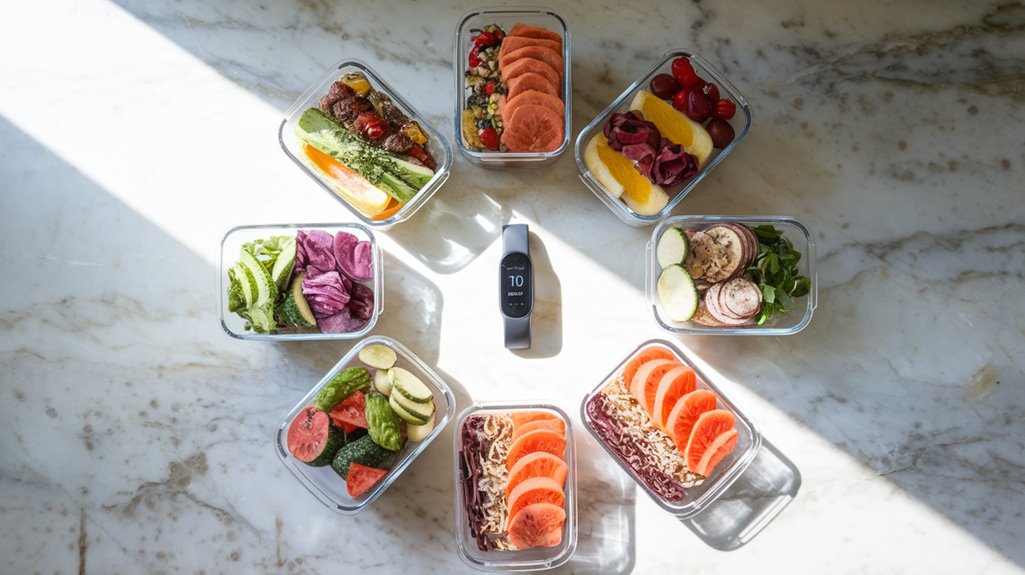
Long-term success on the ketogenic diet requires a thorough approach that extends beyond overcoming initial challenges. You'll need to establish personalized meal plans that align with your specific macronutrient requirements while maintaining nutritional variety. Track your progress systematically using digital tools or journals to monitor both scale and non-scale victories.
Build a robust support network by connecting with keto-focused communities and potentially working with nutrition professionals who understand ketogenic principles. You'll also need to integrate sustainable practices into your lifestyle, including strategies for dining out and social situations. Implement stress management techniques to prevent emotional eating, and continue educating yourself about ketogenic nutrition. Remember to set realistic milestones and celebrate your achievements while maintaining flexibility in your approach through regular assessment and adjustment of your goals.
Frequently Asked Questions
Can I Drink Alcohol While Following Ketocycle 2.0?
You can drink alcohol while on keto, but it'll slow your ketosis. Stick to zero-carb spirits, dry wines, or light beers. Limit yourself to 1-2 drinks and stay hydrated.
How Does Medication Use Affect Success on Ketocycle 2.0?
Your medications can greatly impact ketosis by affecting blood sugar and insulin levels. You'll need to work with your doctor to adjust dosages and monitor for interactions while following a ketogenic diet.
Is Ketocycle 2.0 Safe During Pregnancy or Breastfeeding?
You'll want to avoid low-carb dieting during pregnancy and breastfeeding. Research shows it can increase risks of birth defects, affect milk production, and potentially harm fetal development.
Can I Follow Ketocycle 2.0 if I Have Only One Kidney?
You'll need your nephrologist's approval before starting, as single-kidney patients require careful protein and electrolyte monitoring. Your kidney function, hydration levels, and nutrient balance must be regularly assessed.
Will Ketocycle 2.0 Affect My Thyroid Medication Dosage?
You'll need careful monitoring as ketogenic dieting can affect thyroid hormone levels. Work with your doctor to adjust medication, as T3 levels may decrease and absorption patterns could change during your journey.
Conclusion
You'll find that Ketocycle 2.0 isn't just another diet plan – it's a scientifically-backed metabolic reset. While some critics argue it's too restrictive, research shows that structured ketogenic protocols lead to sustained fat loss and improved metabolic markers when followed correctly. By implementing this week-by-week approach, you're not only transforming your body composition but also rewiring your metabolism for long-term metabolic flexibility and enhanced energy efficiency.
References
- https://www.carbmanager.com/article/ya9dcriaacaa7cp8/keto-2.0-what-you-need-to-know-and-should-you-try
- https://www.healthline.com/nutrition/cyclical-ketogenic-diet
- https://www.youtube.com/watch?v=XWyrPP7XJhg
- https://scottyseveryday.com/blogs/scottys-updates/the-keto-diet-vs-keto-2-0
- https://www.medicalnewstoday.com/articles/327309
- https://www.prevention.com/weight-loss/diets/a30196446/keto-2-0-diet/
- https://twosleevers.com/keto-diet-plan-week-2/
- https://www.eatingwell.com/article/8067257/keto-2-0/
- https://drberg.eu/en/books/196-2-week-keto-meal-plan-digital-version.html
- https://play.google.com/store/apps/details?id=com.kilogroup.ketocycle&hl=en_US
- https://www.vnutritionandwellness.com/keto-cycle-diet-app-review/
- https://foodinstitute.com/focus/keto-2-0-is-less-restrictive-than-keto-is-it-less-effective-too/
- https://ketocycle.diet
- https://bioscope.ucdavis.edu/2020/02/23/the-science-behind-going-keto/
- https://my.clevelandclinic.org/health/articles/24003-ketosis
- https://nutritionsource.hsph.harvard.edu/healthy-weight/diet-reviews/ketogenic-diet/
- https://www.drberg.com/blog/break-the-carbohydrates-addiction-habit-and-increase-your-willpower-now
- https://www.doctorkiltz.com/carb-addiction/
- https://www.ruled.me/eat-cyclical-ketogenic-diet/
- https://www.allencarr.com/en-us/easyway-weight-loss/carb-cravings/



